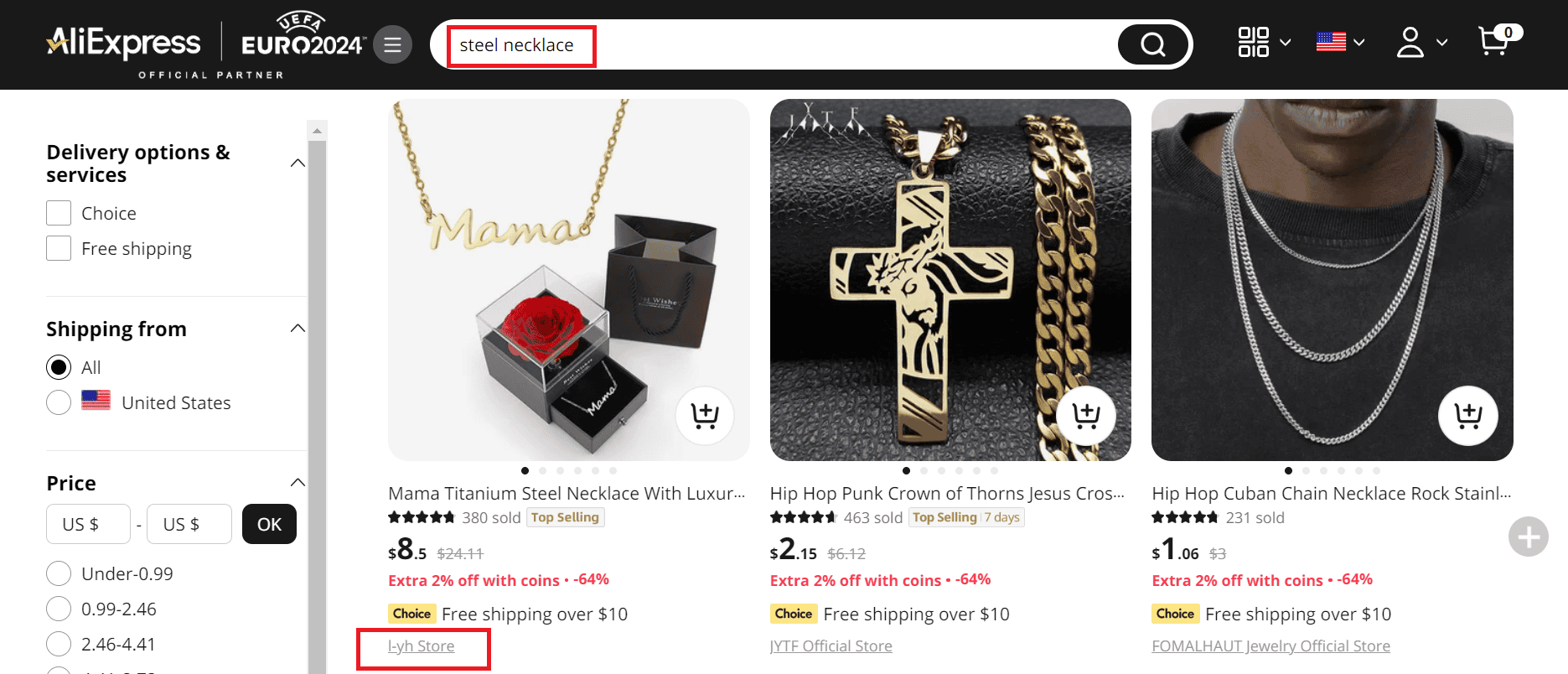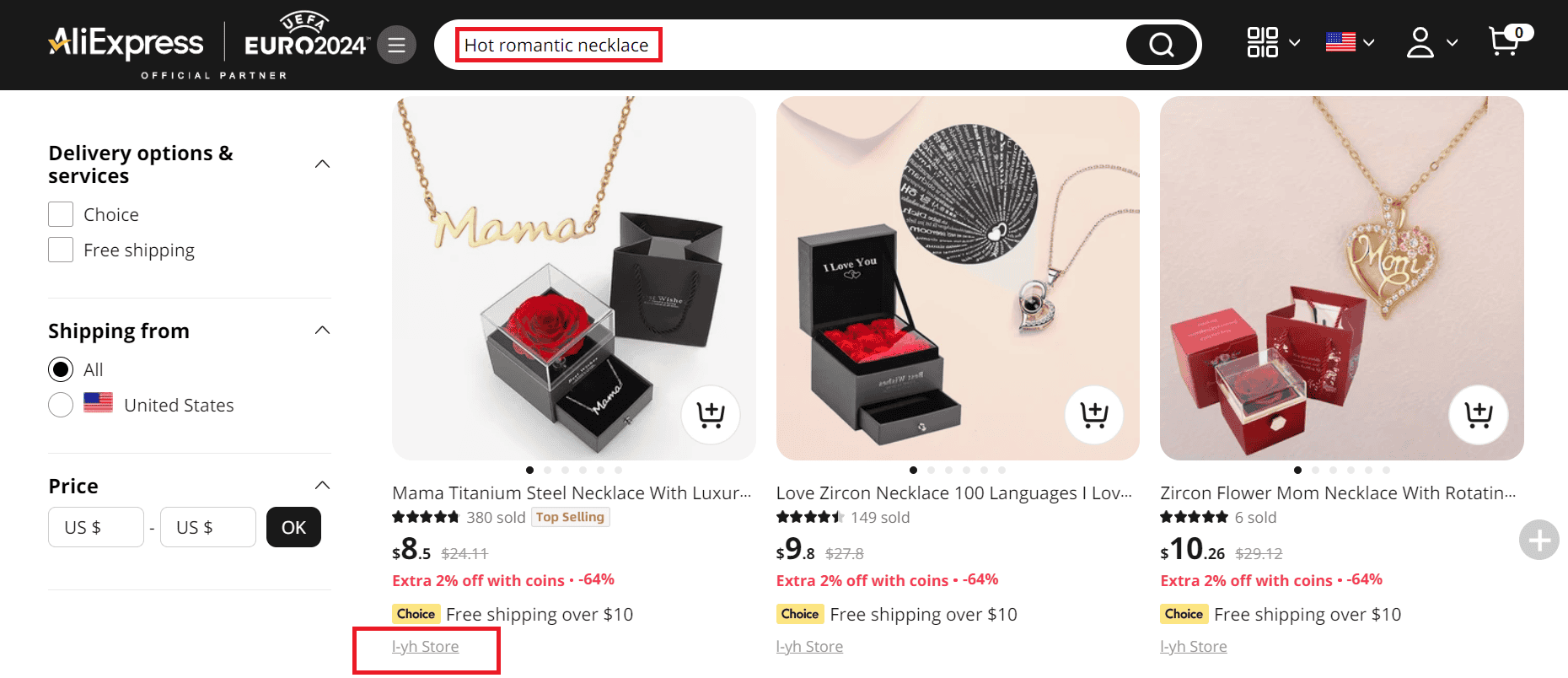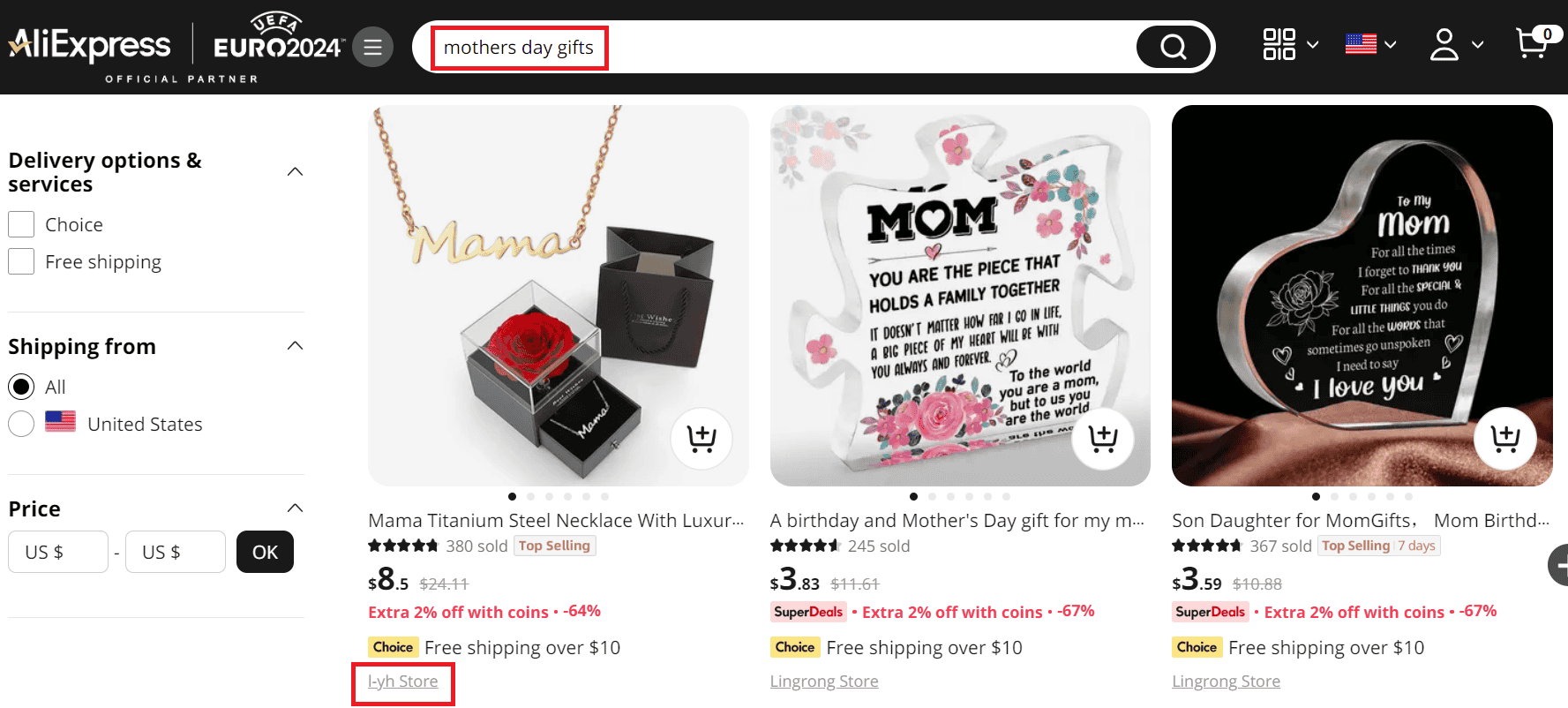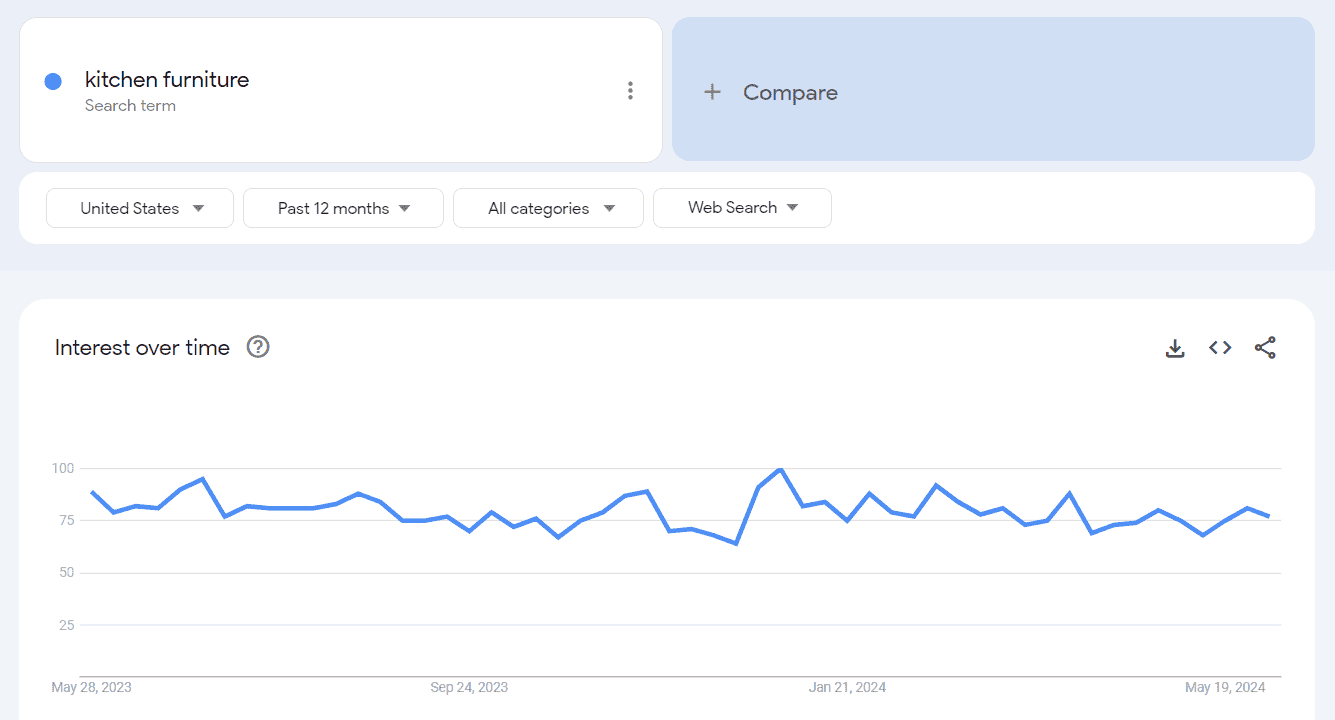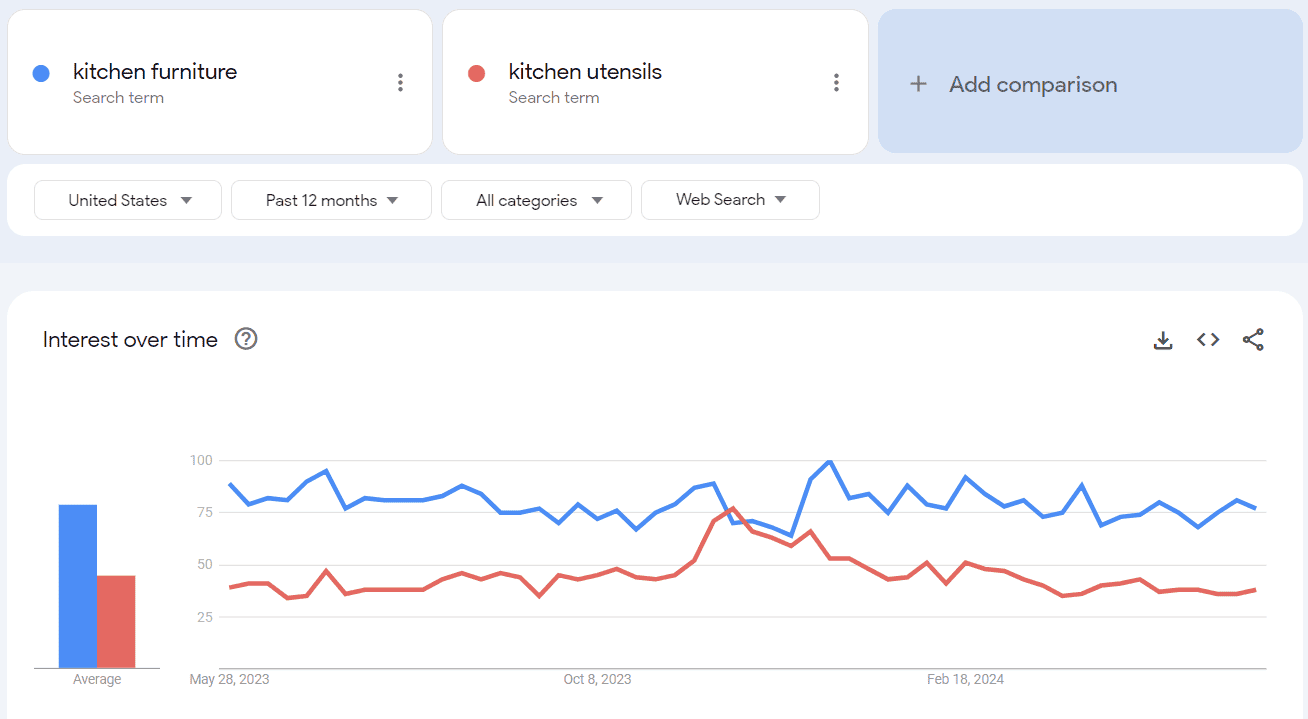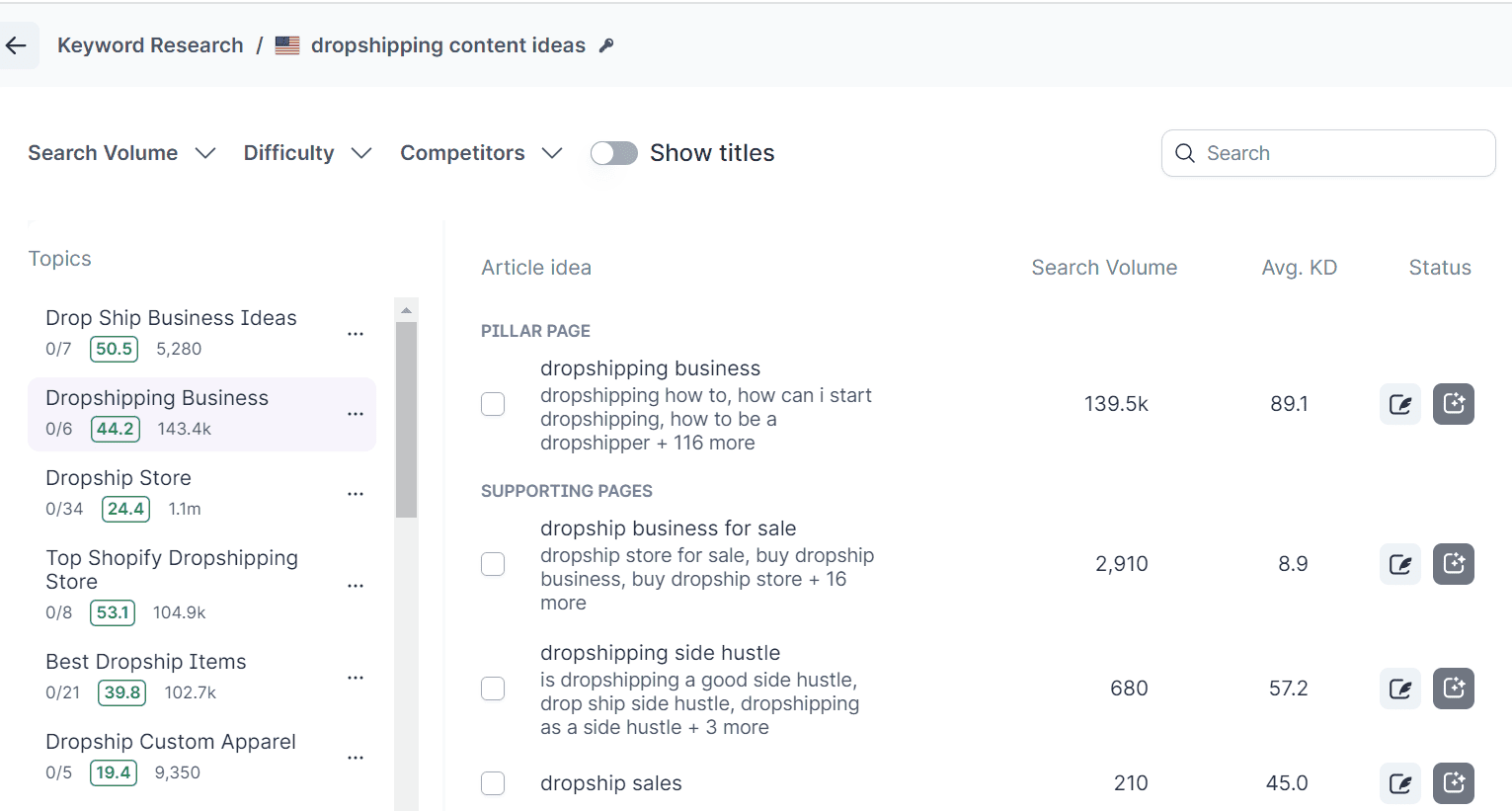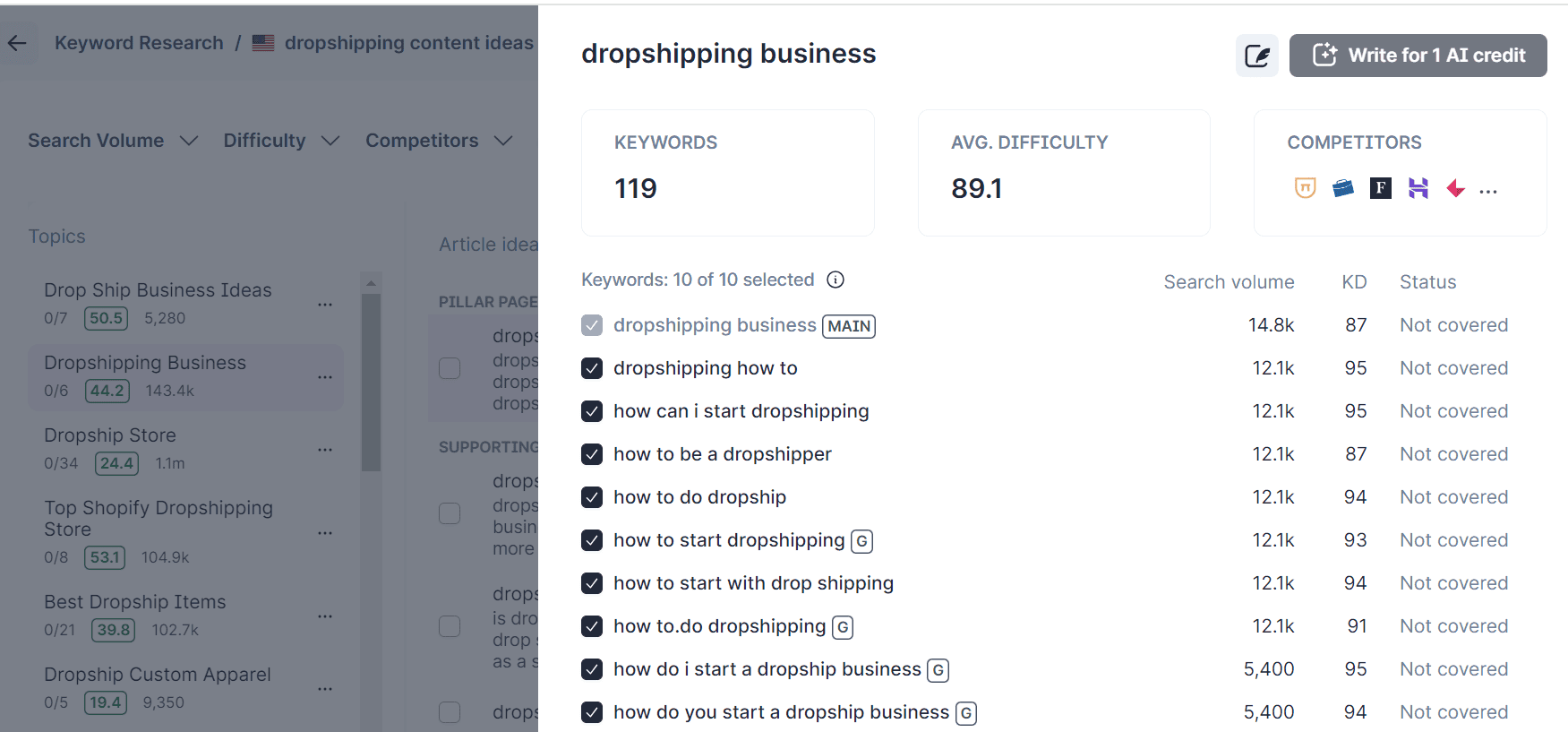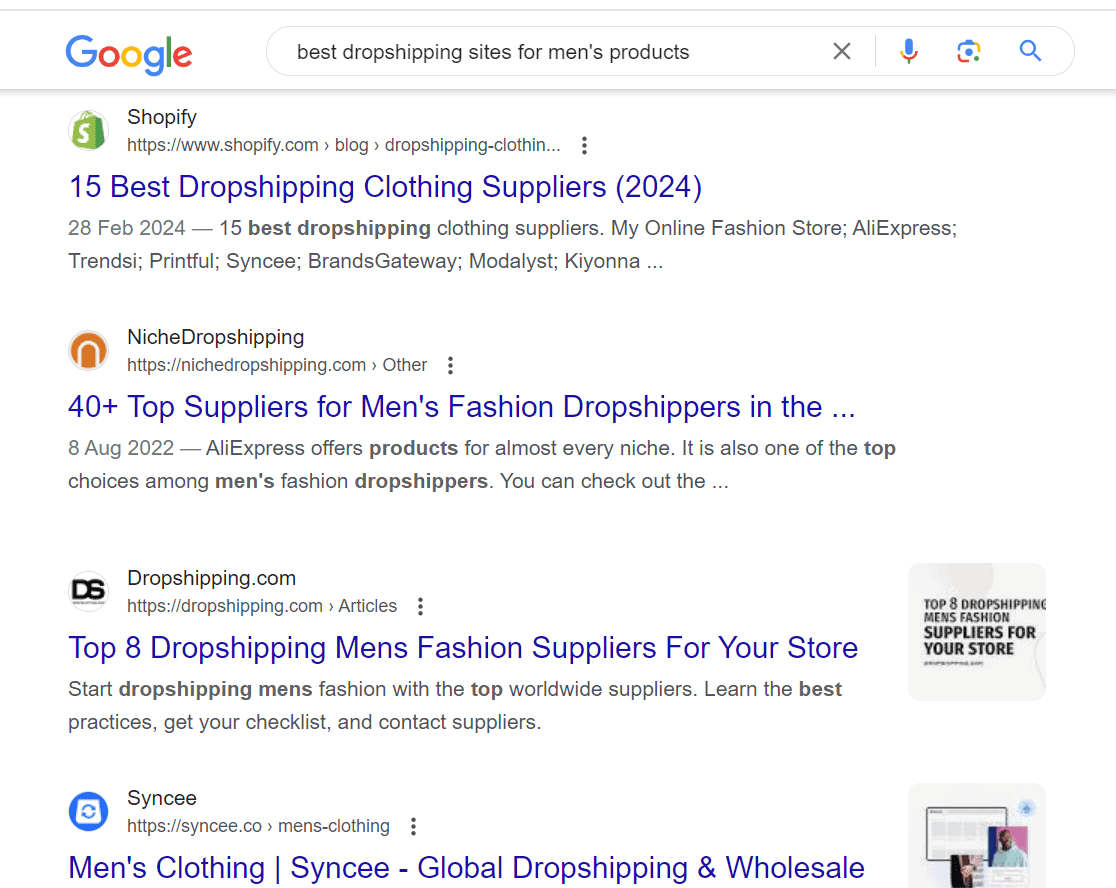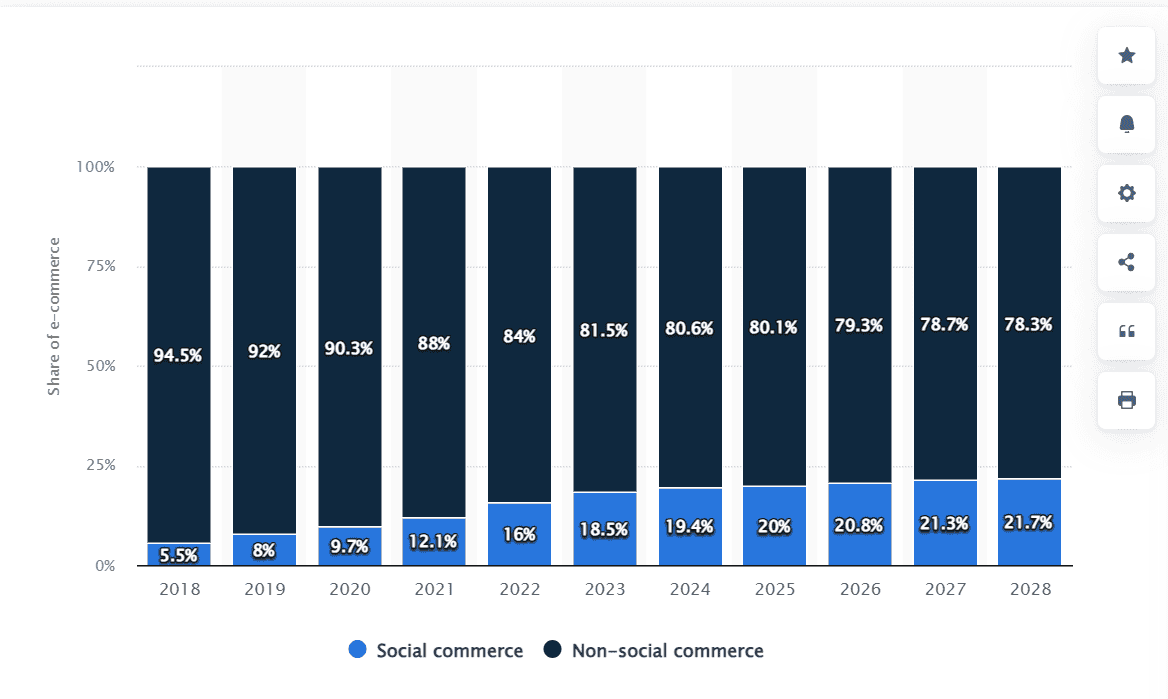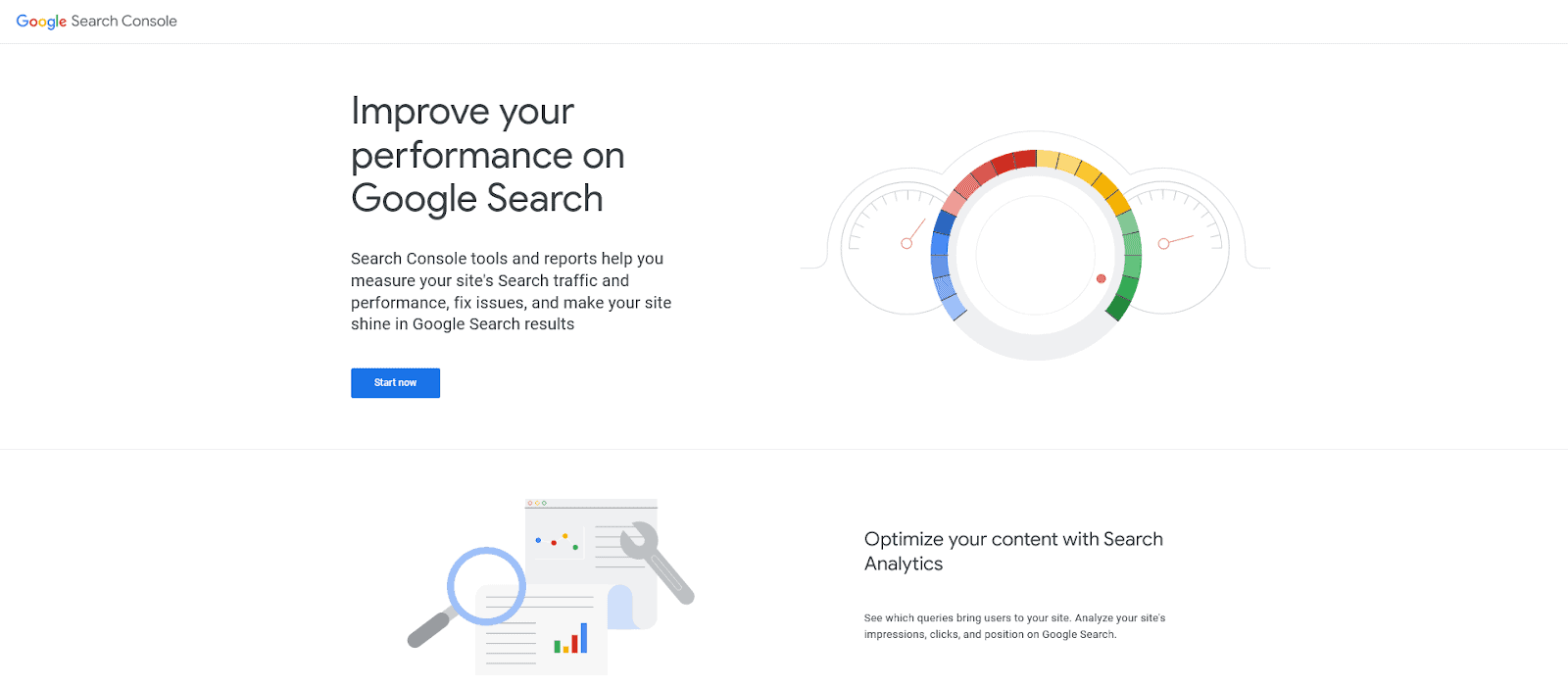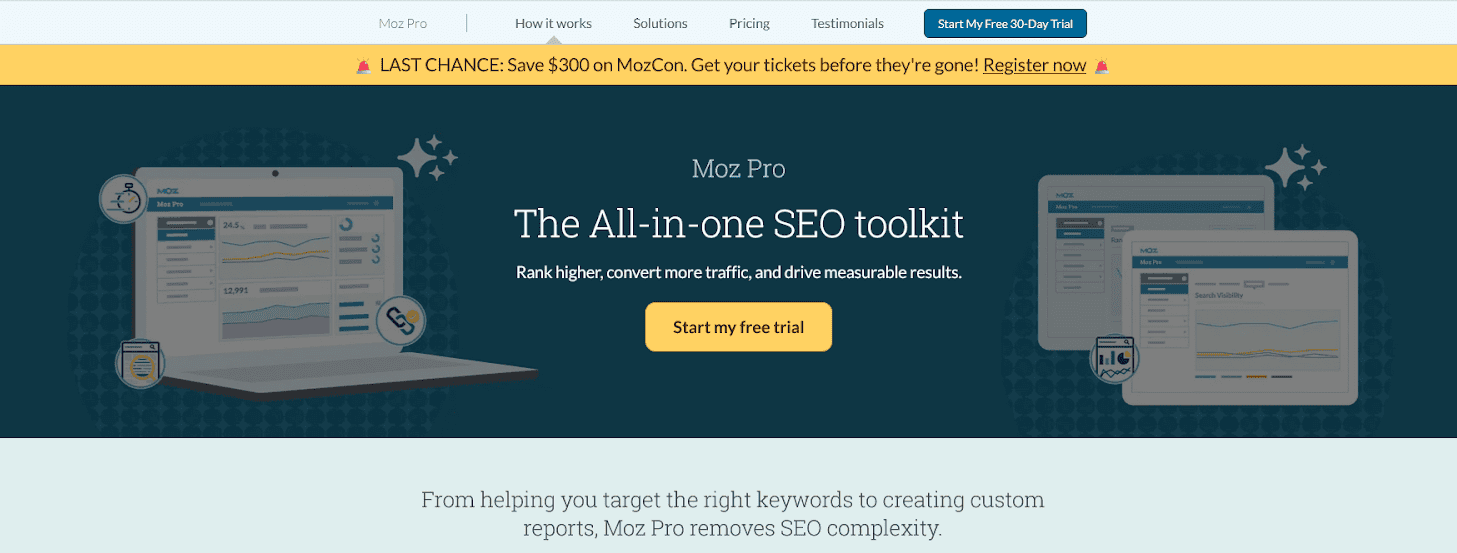Individuals and businesses use SEO for different reasons, all linked to one: improving their online store visibility. According to research, SEO drives 1,000%+ more traffic than organic social media. That’s an impressive figure, but then, what is SEO, and what is its role in dropshipping success?
SEO stands for search engine optimization, and dropshipping involves selling products directly to customers without keeping stock. The dropshipping business model requires tailored marketing strategies, and this is where SEO for dropshipping comes in.
SEO for dropshipping offers one of the highest Returns on Ad Spend (ROAS), making it a more profitable marketing strategy than Google or Facebook Ads.
In this article, we explore SEO strategies for dropshipping businesses to boost visibility, drive organic traffic, and achieve success in sales and revenue.
Let’s get started!
Table of Contents
Key Takeaways
- Conduct keyword research to help you identify the right keywords for your dropshipping niche.
- Ensure your website structure is user-friendly and search engine-friendly, with straightforward navigation and organized categories. Optimize product titles, descriptions, meta tags, and URLs with targeted keywords to attract organic traffic.
- Create high-quality, informative content that addresses the needs and interests of your target audience. Incorporate targeted keywords naturally into your content and leverage different content formats such as blog posts, product guides, and tutorials in your web pages.
- Regularly audit your website for technical issues like page speed and mobile friendliness. Optimize site performance, monitor Google algorithms, fix broken links, and ensure proper search engine indexing of your pages.
- Ensure that the attached backlinks are from reputable websites within your industry. Build a strong backlink profile and focus on natural link-building tactics such as guest blogging, influencer outreach, and content promotion.
- To enhance user engagement and satisfaction, improve your site navigation, optimize for mobile devices, and provide clear calls to action.
SEO for Dropshipping: Understanding The Basics
Search engine optimization (SEO) has many vital concepts guiding it. Here’s a breakdown of basic SEO concepts relevant to eCommerce and dropshipping and how to implement them.
Keyword research
This is a crucial SEO strategy for increasing organic website traffic. SEO for dropshipping involves identifying the right keywords to target in your product listings and dropshipping website.
For instance, the last time you searched online for a gift for a family member or friend, did you use a generic title like “red bag?” You probably searched instead for the “best jewelry set for Mother’s Day” or the “best Mother’s Day gift box.”
This long-tail keyword shows that you weren’t just strolling online but about to make a purchase decision. In the same way, by incorporating relevant keywords that meet buyers’ intent, you get to increase your online store visibility.
Here are some reasons why optimizing your product listing with relevant keywords is essential in dropshipping.
Product visibility
Keywords are essential in ensuring your products are visible to potential buyers in dropshipping SEO. If you choose the right keywords, your products will appear in searches when potential customers are looking for items you offer.
For example, this dropshipping store on AliExpress used long-tail keywords that most buyers search for when purchasing a set of jewelry, as highlighted in the image below. The result is that their product comes up in the top searches for various keywords users search for.
For instance, the same store popped up when I searched for a steel necklace.
When I searched for a “hot romantic necklace,” same-store pooped up.
Guess who popped up when I searched for “Mother’s Day gifts” — the same store. This shows the importance of using the right keywords in your product listing and description.
Additionally, when optimizing your dropshipping store for SEO, optimize your product pages for search engines. Here are some key things to include.
- Title tags: Include primary keywords and keep them under 60 characters.
- Meta descriptions: Write compelling descriptions with calls to action, ensuring they’re under 160 characters.
- Alt text: Use descriptive alt text with relevant keywords for all images.
- File names: Name image files with relevant keywords before uploading.
Understanding buyer intent
Keywords help you understand the intent behind people’s searches. Different keywords can capture the various stages of the buyer’s journey, whether people are looking for information, considering a purchase, or ready to buy.
Market trends
Analyzing keyword trends can help you understand what products are currently in demand, allowing you to adapt your product offerings to match market interest. You can find relevant keywords and analyze their search volume and competition with keyword research tools like Google Keyword Planner or Google Trends.
For example, using Google Trends, you can see how the search volume for specific keywords and the search volume for particular keywords changes over time.
Here’s an example. A search for ‘kitchen furniture’ resulted in this.
You can also compare keywords using Google Trends to identify more relevant keywords to rank for based on users’ searches. When I compared kitchen furniture with kitchen utensils, kitchen furniture was a more relevant keyword than kitchen utensils.
On-page optimization
On-page optimization is anything you do within your webpage to improve visibility and ranking, such as internal linking, content quality, and meta-description. For instance, you want to post quality content on your blog that matches users’ interests.
One way to find relevant content ideas is to search for them on SEO apps like Ahrefs or Surfer SEO.
Using Surfer SEO to search for dropshipping content ideas generates several ideas based on search volume, difficulty, and competitors. This way, you know what users want information on and have content ideas for your blog.
Clicking on a topic idea gives you several article ideas for your pillar and supporting pages. This way, you get valuable insights on content ideas, keyword ideas, search volume, and competitors’ rankings rather than just making posts based on a wild guess. Focusing on low-competition keywords is a simple trick for building your domain authority.
This will increase your chance of ranking on the first page of SERPs.
Additionally, here are some key things to include in your SEO on-page optimization for your dropshipping eCommerce website.
- Title tags: Include primary keywords and keep them under 60 characters.
- Meta descriptions: Write compelling descriptions with calls to action, ensuring they’re under 160 characters.
- Alt text: Use descriptive alt text with relevant keywords for all images.
- File names: Name image files with relevant keywords before uploading.
- Easy navigation: Create a clear, intuitive navigation structure.
- Link value: Use internal links to pass value between pages, especially from high-authority to essential product pages.
- Relevant anchor text: Use descriptive anchor text for internal links.
- Handling out-of-stock: Keep pages live with recommendations for similar products or allow back-in-stock notifications.
Product descriptions
Product descriptions give potential buyers a detailed idea of your product: makeup, benefits, and features. A good product description should ideally cover the Why, When, What, and How questions in your target audience’s mind:
- Why should I buy this product
- What are the benefits of this product
- How Is this product the best fit for me
- When can I get this product
Writing an engaging meta description that includes relevant keywords is an excellent dropshipping SEO strategy for improving your dropshipping store visibility and increasing click-through rates.
Backlinks
Backlinks drive traffic to your site from other websites. It’s other sites telling potential customers to check out your website. Building backlinks from reputable websites goes a long way to help improve your website’s authority and search engine ranking.
Read also: How To Find Reliable Dropshipping Suppliers: A Quick Guide
Technical SEO for Dropshipping Stores
Technical SEO plays a significant role in the success of drop-shipping websites because it directly affects how search engines index, crawl, and rank the site. In addition, technical issues can hinder a site’s visibility and user experience, which can, in turn, impact sales and conversions.
Here are the four most critical technical SEO factors to implement for the best results.
- Website speed
- Mobile optimization
- Navigational structure
- Secure and reliable hosting
Website speed
Your page’s loading speed is a ranking factor in SEO optimization. Fast-loading pages generally decrease bounce rates and potentially increase visitors’ time on-site. An ideal load time is between 0 and 3 seconds. Google prefers to rank pages that load quickly, especially on mobile devices.
When a site loads faster, users visit more pages. For eCommerce websites, the more product pages are viewed, the higher the chances of conversion.
Mobile optimization
Mobile eCommerce sales are projected to reach $710 billion in 2025, and approximately five in ten shoppers use their phones to shop once daily. If your website is not optimized for mobile, you are letting sales opportunities slip through the cracks.
Google indexes and ranks your uploaded content using the mobile version, which is why a mobile-friendly site is essential.
Navigational structure
The navigational structure describes how your page is organized, making it easy for website visitors to find what they are looking for without confusion. Here are the key points that make up the navigational structure and their impact on SEO.
User navigation
A clear and intuitive navigation structure helps users find relevant content, reducing the bounce rate and increasing dwell time.
Site hierarchy
A logical site hierarchy helps search engines understand your website’s structure and the importance of each page. You should structure URLs to reflect the site hierarchy (e.g., homepage > category > subcategory > product).
Clean URLs
Clean, descriptive URLs that include keywords relevant to the page content benefit users and search engines.
Link equity
Effective internal linking helps distribute link equity throughout your site. Adding internal links to your content helps search engines understand the context and relationship between different pages on your site.
Read also: How to Find Business Keywords to Rank Better on Search Engines
Secure and reliable hosting
Secure and reliable hosting plays a significant role in the overall SEO performance of a website, including the following.
Uptime
Using reliable hosting ensures your website is always accessible to users and search engines. This reduces downtime, which can harm your SEO and cause your site to be unreachable.
Security
Secure hosting with HTTPS encryption is necessary because Google uses HTTPS as a ranking signal. Secure hosting protects your site from malicious attacks and data breaches, which can significantly impact your SEO and user trust if compromised.
Server location
Your server’s location can affect site speed, especially if your audience is far from where your server is hosted.
Read also: Dropshipping Profitability: Exploring the Real Potential of Your Online Business
SEO for Dropshipping Strategies
Now that we have examined the technical SEO factors to implement for your dropshipping business, let’s discuss some dropshipping SEO strategies.
Build a robust content strategy
One potent way to drive traffic to your store is through content marketing. Creating valuable and informative content, such as blog posts and videos, increases your online store’s organic traffic. For example, a search on Google for the best dropshipping sites for men’s products resulted in this.
A content strategy that complements your product offerings can help establish your brand, educate your customers, and improve your search engine rankings. Here’s how to develop a content strategy that works for your dropshipping business.
Plan your content
Understand who your customers are, what they need, what they value, and how they search for your products. Then, research to find topics and terms related to the products your audience is searching for (we already covered how to do this above).
Use unique product descriptions
Unique descriptions prevent your site from being penalized for duplicate content, which is common in dropshipping. They also allow you to target less competitive keywords and be more specific to your customers’ searches by answering potential buyers’ questions.
Support product pages with blogs and articles
As an eCommerce seller, attracting traffic to your product page is very important. One of the best ways to achieve this is by having a blog and promoting your products on the blog. Here are five tips for using a blog article to support product pages and boost ranking.
- Create blog posts that educate your audience about your products, how to use them, and their benefits.
- Use internal links to link your blog posts to specific product pages.
- Write articles that address common problems or questions related to your products and provide solutions.
- Update your blog with informative content to keep your site active and engaging.
- Use storytelling to make your products more relatable and to create emotional connections with your audience.
Build quality links
Quality backlinks are a critical factor in search engine algorithms. They increase your website’s authority, relevance, and visibility in search results. Here are some techniques for earning backlinks.
Partnerships
You can partner with influencers in your niche to get your products featured with a backlink to your site to earn backlinks. You can join joint ventures with complementary businesses to share content and backlinks.
Reviews
You can also earn backlinks by sending your products to bloggers and reviewers in your industry. If they publish a review, it’s likely to include a backlink to your product page. As a drop-shipper, you can offer testimonials for your services or products, which may result in a backlink from the provider’s website.
Guest posts
Write valuable and informative content for reputable sites in your niche. When you visit those sites, ensure that your post aligns with the host site’s standards and audience interest. You can also consciously work on your relationships with blogs and contribute regularly to increase the chances of earning backlinks.
Leverage social media
Social commerce has grown in popularity. In 2023, it accounted for 18.5% of total online sales and is projected to account for one in five sales by 2025, according to a Statista report.
Monitoring your social signals is one way to gauge your marketing success and increase brand awareness. Social signals are metrics on social media, such as comments, likes, reposts, shares, etc., that quantify the success and engagement of a post.
Although social signals don’t directly increase your Google ranking, they help generate online traffic. These signals are considered factors in determining a web page’s credibility, authority, and relevance in search engine rankings.
Here are some of its impacts:
- Social signals can increase your content’s visibility, leading to more traffic. This traffic can signal that your website is valuable and relevant.
- High engagement on social media can lead to more shares and, potentially, more backlinks to your site as users reference your content.
- A solid social media presence can build brand recognition, leading to online branded searches.
- Social signals can speed up the indexing of your content on search engines because search engine bots constantly crawl social media platforms.
Strategies for using social media to enhance product pages and SEO
Here are some strategies that you can employ while using social media to improve the outlook of SEO and your product page.
- Optimize social profiles: Ensure your social media bio is optimized with relevant keywords, a good description of your business, and a link to your website.
- Share quality content: Share valuable and relevant content with which your audience will engage.
- Use hashtags wisely: Hashtags increase the reach of your social media posts and make them discoverable to a broader audience.
- Engage with your audience: Respond to comments, questions, and messages. Engagement can boost your posts’ visibility.
- Promote your products creatively: Use attractive visuals and compelling copy to promote your products without being overly persuasive.
- Leverage influencer partnerships: Partner with influencers to reach a larger audience and build credibility.
Examples of successful social media campaigns that boosted SEO
Many businesses have experienced successful social media campaigns that boosted their SEO on search platforms. Here are a few examples.
GoPro’s user-generated content
GoPro encourages its users to share their videos taken with its cameras. This content is often shared across social media, increasing their online visibility.
Airbnb’s hashtag campaigns
Airbnb has used hashtag campaigns like #LiveThere to encourage users to share their travel experiences. These campaigns often go viral, increasing brand recognition and search interest.
Dollar Shave Club’s viral video marketing
Dollar Shave Club’s launch video became a viral sensation on social media. This increased its brand awareness and led to many backlinks, boosting its SEO.
Wayfair’s visual content
Wayfair shares high-quality images of its products in styled home settings, encouraging users to share and tag their purchases. This increases user engagement and can improve online visibility.
Nike’s influencer collaborations
Nike frequently collaborates with athletes and celebrities to create content that resonates with their audience.
Improve website user experience
User experience plays a massive role in determining a website’s search engine optimization (SEO) rankings. Here are essential factors to consider when improving your user experience.
Consider ranking factors
Online search platforms like Google prioritize websites that offer a seamless and valuable user experience. Factors like page load speed, mobile friendliness, and content relevance contribute to a positive user experience, impacting SEO rankings.
User satisfaction
Websites that provide a positive user experience are more likely to satisfy visitors, leading to higher rankings as search algorithms interpret positive user signals.
Trust and authority
A well-designed and user-friendly website builds trust and authority, which is essential for dropshipping SEO. Trustworthy sites are also more likely to attract natural backlinks and social shares, which are important SEO factors.
Tips for improving user experience on dropshipping websites
Here are some notable tips you can employ to enhance customers’ experience on your dropshipping website.
- Mobile optimization: Ensure the website is fully optimized for mobile devices, as many users access websites through mobile platforms.
- Fast loading times: Optimize images, leverage browser caching, and invest in reliable hosting to improve page load speed.
- Straightforward navigation: Your site should also have intuitive navigation, ensuring visitors can easily find the products and information they seek.
- Optimize checkout process: Simplify the process to reduce cart abandonment and improve user satisfaction.
- Customer reviews and testimonials: Incorporate customer reviews and testimonials on your website to build trust and social proof and positively influence customers’ actions.
Read more: Customer Service for Dropshipping — A Detailed Guide
Search Engine Optimization Tools and Software
SEO software and tools are essential for optimizing websites and improving search engine ranking. Here’s an overview of some crucial SEO apps and how they can benefit your website.
These tools can also provide actionable SEO tips for dropshipping businesses, enhancing their online visibility and performance.
Google Analytics

It provides a wealth of demographics and conversion data to help you understand how visitors interact with your site. The data you obtain gives you insight into how to further tailor your dropshipping SEO strategy to customers’ preferences and needs.
You can see where your traffic is coming from, organic or not. If you know where your traffic is coming from, either from organic search or paid advertising, you can identify the channels contributing more to your business.
Google Search Console
It is a free tool provided by Google that helps you monitor your website and gather data to improve its presence in Google Search results. When you use the tool, you receive data on your website’s performance, including its average position and click-through rate.
The tool also offers insights on how Google indexes your website.
Due to its direct connection to Google, Google Search Console also allows you to inspect individual URLs on your website and see how Google views them, making it easy to spot any error or issue that might negatively affect your visibility.
Semrush
Semrush is another comprehensive tool that can help you run your SEO campaign successfully. It offers a wide range of features for optimizing your website for online users.
It is an all-in-one platform that offers competitor analysis, research, backlink analysis, site auditing, content marketing, and rank tracking. Semrush is a one-stop solution known for its accuracy and reliability in data. With Semrush, you do not have to worry about getting the wrong data.
Its vast database and advanced algorithms make it easy to access accurate data.
Ahrefs
Ahrefs is famous for its extensive backlink database, with over 30 trillion backlinks indexed. This tool is on par with SEMrush in that it also has a wide range of features that can help your business be more visible.
With Ahrefs, you can analyze competitors. Its robust competitor analysis tools allow you to gain insights into your competitors’ SEO strategies. This tool has a unique content gap analysis feature that allows you to identify content opportunities by comparing your website with a competitor’s.
The chance to do this with Ahrefs enables you to create targeted content that fills the gap and increases your Google ranking.
Moz Pro
Moz Pro is a comprehensive toolset that helps you optimize your content to rank higher and gain more visibility online. This tool recommends improving your title tags, meta descriptions, headings, and other on-page elements for maximum relevance and visibility.
Moz Pro is unique because it offers two important metrics – Moz Trust and MozRank. These metrics provide insights into the authority of a website’s backlink profile. You can assess the quality of a backlink and prioritize your effort based on the insight obtained from Moz Trust and MozRank.
What to do with these tools
While using these tools, here are two significant things to do.
Competitor analysis
Use them to benchmark your site against competitors, discover keywords to rank for, and identify strengths and areas for improvement. Also, use them for backlink analysis by examining competitors’ backlink profiles to identify linking opportunities for your site.
SEO monitoring
Check your website to see which keywords bring in the most traffic. Regularly audit your site using tools that check for technical issues, broken links, and on-page optimization opportunities and see how SEO changes impact traffic and user behavior.
Lesser-known tools that offer a competitive edge
Some SEO tools are less popular but offer a competitive edge to dropshipping business owners.
- Screaming Frog SEO Spider: This in-depth crawling tool can identify technical issues on your site that may affect SEO performance.
- SpyFu: Provides detailed insights into the keywords your competitors have been successful in, both in organic search and paid ads.
- Ubersuggest: It is a free tool by Neil Patel that offers keyword suggestions, content ideas, and insights into the strategies that work for others in your market.
- Answer the public: This tool shows you questions people are searching for online, which can inform content creation for your blog or FAQ pages.
Read more: Best Dropshipping Platforms for New Entrepreneurs: A Guide
SEO Mistakes to Avoid in Dropshipping SEO
Individuals in dropshipping businesses often face unique challenges regarding search engine optimization (SEO).
Here’s a rundown of the common SEO mistakes that people make in dropshipping, how these mistakes can negatively impact rankings and sales, and best practices for avoiding and correcting these mistakes.
Thin or duplicate content
Using manufacturer-provided descriptions without modification can result in duplicate content issues. Moreover, having thin content across product pages can lead to poor search engine visibility.
Lack of niche keyword targeting
Failing to target specific long-tail keywords related to the products being dropshipped can lead to low search visibility and an inability to capture relevant traffic.
Ignoring on-page SEO
Neglecting on-page SEO elements such as meta titles, descriptions, and image alt tags can hamper the discoverability of product pages.
Slow loading times
Many dropshipping sites have slow loading times due to extensive product images, which leads to poor user experience. Another impact noticed is decreased traffic. When dropshipping online stores rank poorly for relevant keywords, they miss out on organic traffic, leading to fewer potential customers visiting the site.
Also, if the website provides a good user experience or the product pages need more optimization, it can reduce conversions and sales.
Read also: Dropshipping Product Description Guide For Beginners
Conclusion
In this blog post, we have covered the full scope of SEO for dropshipping and shown you how to implement it.
SEO for dropshipping offers one of the highest Returns on Ad Spend (ROAS), making it a more profitable marketing strategy. However, comparing its long-term benefits against the immediate but costly traffic from paid advertising like Google Ads is essential.
If you are new to dropshipping SEO, take your time trying to do it all. Instead, you can begin by building a blog page to support your product pages and optimizing your product titles and descriptions with keywords potential customers search for to increase online visibility.
Frequently Asked Questions
How long does it take to see results from SEO for a dropshipping site?
It typically takes around 4 to 6 months to start seeing noticeable results from SEO for a dropshipping site. However, the timeline can vary based on factors such as the niche’s competitiveness, the SEO strategy’s quality, and the site’s domain authority.
Can SEO alone drive sufficient traffic for dropshipping business success?
Yes, SEO alone can drive enough traffic for dropshipping success. However, it is most effective when combined with other marketing strategies, such as social media marketing, influencer partnerships, and content marketing.
What are the best SEO practices for a multi-product dropshipping store?
Conduct thorough keyword research to identify relevant search items for each category, implement a clear site structure with user-friendly navigation to enhance user experience, focus on building relevant backlinks from reputable sources, and consistently analyze and monitor your site’s performance.
How frequently should I update my SEO strategy for my dropshipping business?
It’s advisable to review and update your strategy for your dropshipping business at least every six months to keep pace with evolving search engine algorithms, industry trends, and changes in consumer behavior.
Are there any specific SEO considerations for international dropshipping?
By tailoring your keyword strategy, utilizing geotargeting, and optimizing website loading speed, you can effectively enhance the visibility and accessibility of your dropshipping business in international markets. These practices will improve your search engine rankings and your international audience’s user experience.


